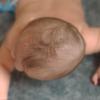DEFINITION
As occipital plagiocephaly is characterized the asymmetry and flattening at the posterior part of the head (occipitoparietal area) (as mentioned in the chapter of craniosynostoses).
The determination "positional" is referred to the cause of plagiocephaly, which is the outer (pre- or post-natal) pressure in the cranial bones. This means that it is attributed to mechanical causes such as:
- In the deformation that the skull is undergone in utero (with a very high frequency in twins)
- In prolonged staying of the new-born baby in one place.
DESCRIPTION OF CLINICAL FINDINGS
It has been reported that the occipital plagiocephaly is characterized by the flattening of the posterior part of the head. Usually, the problem is located on one side, but it may be related in both sides and so it is created the image of symmetrical flattening. This flattening causes the head to appear wide above the ears and short from front to back.
On the opposite side of the head is caused compensating malformation with ascension and increased curvature of the occipital and parietal area.
In the most severe forms of plagiocephaly, it is often observed anterior displacement of the ipsilateral side of the forehead and ear.
The positional plagiocephaly is the most frequent cause for the asymmetry of the skull.
The increasing incidence of occipital plagiocephaly that is observed over the last twenty years is attributed largely to the directive that is adopted by the American Academy of Pediatrics in 1992, according to which newborns should be placed in a supine position during sleep to significantly reduce the Sudden Death Syndrome.
ETIOLOGY
As we have already mentioned above, the occipital positional plagiocephaly is attributed to external pressure exercise. But the things are not so simple, it should go in with other factors, such as:
- Neonatal hypotonia that favours the staying in the same position.
- Cervical muscle spasm (congenital muscular torticollis or twisted-neck or wryneck) that is the frequent finding and confines the maintenance of the head of the infant on one side. Children with Congenital Muscular Torticollis (CMT) develop plagiocephaly in a percentage of 80-90% (photo).
• Strabismus, which although is not a frequent finding, it leads to poor positioning of the head that secondarily it causes cervical muscle spasm.
TREATMENT
The treatment of occipital positional plagiocephaly, except from the most severe forms, it is conservative and consists in:
- Frequent change of head position
- Position of the head in a specially designed hollow pad by foamy material
Treatment with a specially designed helmet has not proven effective and tends to be abandoned.
For the most severe forms of plagiocephaly, the solution is a surgery during which is performed cranioplasty of the posterior part of the head. During this operation, it is improved the aesthetic problem of the patient and simultaneously it is ensured the local decompression of the skull which is pressed from the occipitoparietal bone.
Once the diagnosis of occipital positional plagiocephaly is done, parents should visit:
- A special neonatal physiotherapist who will examine and evaluate the infant for muscle spasm, he/she will indicate the appropriate exercises to parents and undertake an active part in the transaction of the newborn (or infant) treatment.
- A special paediatric ophthalmologist (Eye MD) in order to preclude the existence of strabismus.
The treatment should start on time; the ideal period of time is during the first two or three months of life because the conservative treatment at an older age is less effective.
It should be noted that the occipital positional plagiocephaly doesn’t affect only the head and neck, but it may also affect the muscular balance in shoulder girdle. This problem is prevented with early physiotherapy intervention.
FUNCTIONAL PROBLEMS
Children with occipital positional plagiocephaly may experience cognitive or learning problems to a somewhat increased percentage during the preschool years. It should be noted that mentally, the percentages are identical to those of the general population. For this reason, it is recommended an evaluation by an experienced developmental-behavioral paediatrician once a year, so with the first signs to begin an early intervention that will minimize the subsequent consequences.
Here are some newborns that deserve our special attention:
- Premature newborns
- Newborns with developmental delay (motor & mental)
- Newborns who show a clear preference of orientation
The prone position (facing down) provides increased sensorimotor challenges and experiences that promote the normal and prompt psychomotor development of the baby, while, at the same time, it is ensured the necessary interval from the pressure on the posterior part of the skull.
It would therefore be advisable, from the first pediatric visit that parents should:
- Be informed about the risks of the prolonged pressure on the posterior part of the skull
- Be encouraged to use the prone position (hug, transportation, game), in order to ensure the necessary balance in the motor development of their child
- Be trained in the care of their child, avoiding typical handlings and to the proper technique and use of the neonatal transport equipment as well.
Remember::
- The skull is very "supple" till the 4th week of age.
- For any deformations that have been caused during birth, it should be made efforts for their rehabilitation as soon as possible.
For these reasons, you should give a special attention to the following:
- If you find flattening points in the occipital or parietal bone, please, talk to your paediatrician.
- If you notice asymmetries in the active or/and passive motion trajectory of the head, please, seek for a physiotherapy assessment.
- If an abnormal shape of the head persists after the 6th week of age or it seems to be abnormal by birth, please, refer to a craniofacial team.
You can help to immediately reduce the incidences or severity of the plagiocephaly cases. You can certainly do it!




